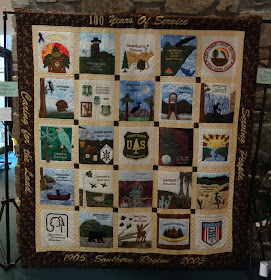Four miles
south of the Blue Ridge Parkway on Highway 276 is the Cradle of Forestry in America Historic Site, the birthplace of forest conservation in America. Located
in the Pisgah National Forest, the Cradle of Forestry has long been on our list
of places to explore in the region. Our first visit (which must have been 15
years ago!) was on a cold day sometime in the winter months, and it was closed –
turns out it’s staffed by volunteers and closes seasonally, reopening in April
weather permitting. Many years later we returned, this time on a long summer’s
day – and missed their operating hours by a few minutes! On our recent day trip
to Pisgah I thought we could try again, especially after I read the day of our
visit was garden day; a chance to work in the gardens and hear from interpreters
, the schedule included planting
in the heritage garden, cleaning up the pollinator garden, a visit to the Cradle’s Monarch Waystation and
discourse on the conversion from turf to meadow.
Knowing
that even with an early start, the 1.5 hour travel time from Greenville combined
with the 2.2 mile Sam Knob hike wouldn’t leave a lot of time at the Cradle, I
still felt it worth the stop. We arrived with two hours until closing, which
definitely is not enough to fully explore the historic site. For that at least
a day is needed, and that’s not including any special interpretive walks. Two
hours was enough for a hike on one of the Cradle’s paved trails and a stop in
the Forest Discovery Center.
 |
| pink lady's slipper |
 |
| squawroot |
Forestry
education really began in 1889, when George W. Vanderbilt purchased the first land
holding in Asheville for his Biltmore Estate and hired Frederick Law Olmsted to
oversee the design and construction of the gardens. Then he hired a young man by the
name of Gifford Pinchot to serve as a “Forest Manager”, a previously unheard of
position. Pinchot developed and implemented a forest management plan for Vanderbilt’s
forested holdings and went on to serve as the first Chief of the USDA Forest
Service and Governor of Pennsylvania. Pinchot’s successor at Biltmore was the German
forester, Dr. Carl A. Schenck, who over the next 14 years restored the
over-farmed and abused lands that today make up Pisgah National Forest into a productive
forest.
 |
| the fish hatchery |
We
started our visit on the Forest Festival Trail, the 1.3 mile paved woodland
walk that incorporates forestry and biology topics with historical features
such as an antique portable sawmill and a 1915 Climax locomotive. The kids
enhanced their hike by participating in the Adventure Zone stations, a collection
of hands-on activities exploring various topics correlating to the trail exhibits.
What’s unique about the Adventure Zone is that it’s designed to help children
and adults with autism become active in and help better understand the
natural world, although it can be enjoyed by anyone and all visitors are
welcome to participate. And as that wasn’t enough, they also completed the
nature-based scavenger hunt specifically structured around the Forest Festival
Trail.
 |
| the historic 1915 logging locomotive |
Back
at the Center we explored the interactive exhibit hall. The Forest Discovery
Center was amazing, with a fire fighting helicopter simulator and an ‘underground’
tunnel to become aquainted with the animals living under the forest floor. A building
station and more than a dozen exhibits on forestry, the region’s history and
Forest Service technicians kept us busy until it was time to leave – the Cradle
was closing for the day.
 |
| checking out the firefighting video in the helicopter |
The
Cradle of Forestry is a must-see attraction for the area, a perfect stop for
families with children and those interested in forestry and forest-related
topics. In addition to special programs, on Thursdays through Sundays you may
find a toy maker, a weaver, a quilter, or a wood carver demonstrating
traditional Appalachian crafts on the open porches of the historic cabins. In addition to the special events calendar, be
sure to check out the kid’s summer program, and consider the Cradle for your
school/group’s field trips. We still have several more trails to explore, and I
would like a chance to watch the “There’s Magic at the Cradle” movie, so I know
for a fact that we’ll be back.
 |
| In commemoration of the centennial celebration of the Southern Region of the US Forest Service |

No comments:
Post a Comment